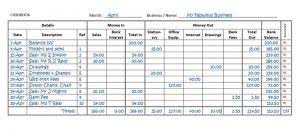
By comparing financial statements over several years, businesses can determine whether they are improving or experiencing financial challenges. Brixx can facilitate both horizontal and vertical analyses, empowering users to gain a comprehensive understanding of their financial statements. With Brixx, businesses have access to powerful tools to help them in analyzing trends, setting benchmarks, and understanding their financial position in the context of their industry standards. Vertical analysis breaks down your financial statements line-by-line to give you a clear picture of the day-to-day activity on your company accounts. It uses a base figure for comparison and works out each transaction recorded in your books as a percentage of Retail Accounting that figure.
- By examining the proportional changes in these components, you can evaluate the company’s financial structure, liquidity, and leverage.
- This helps you compare transactions to one another while also understanding each transaction in relation to the bigger picture, rather than simply in isolation.
- This helps us understand the composition of the balance sheet and identify any significant trends or deviations.
- Interpreting financial data, especially complex datasets, can pose challenges, even for seasoned professionals.
- For example, the amount of cash reported on the balance sheet on Dec. 31 of 2024, 2023, 2022, 2021, and 2020 will be expressed as a percentage of the Dec. 31, 2020, amount.
Analysis of Cash Flow Statement
For each line item, we’ll divide the amount by the corresponding period’s revenue to arrive at our contribution percentages. Starting from the revenue line item, each line item on the income statement – if deemed appropriate – is divided by revenue (or the applicable core metric). Once the historical data from 2021 has been inputted into Excel, we must determine the base figure to use. Vertical analysis does not account for external influences such as economic conditions, market competition, or changes in consumer behavior. If you’re new to the balance sheet, understanding each of its components can seem like an overwhelming and ledger account complicated ordeal. Any investor with a genuine interest in the business will want to see detailed financial pitch deck slides to gain an understanding of…
How to Create an Emergency Business Plan in a Day
- If you see that a company is spending a large percentage of its revenue on certain expenses, you can dig deeper to see if those expenses are justified or if there are opportunities to reduce costs.
- Once the historical data from 2021 has been inputted into Excel, we must determine the base figure to use.
- To fully understand how important the results are, compare them with industry averages.
- For example, Apple’s gross margin in 2018 was 38.34%, slightly down from 39.08% in 2016.
Employing these tools in tandem will ensure a more rounded and in-depth analysis, facilitating better business strategies and fostering company growth in an ever-competitive landscape. In this vertical analysis, we express each item on the balance sheet as a percentage of the total assets (for assets) or total liabilities and equity (for liabilities and equity). This helps us understand the composition of the balance sheet and identify any significant trends or deviations. According to a recent report by the Corporate Finance Institute, AI-driven tools have significantly improved the efficiency vertical analysis and accuracy of vertical analysis.

Vertical vs. Horizontal Analysis

You can use vertical page analysis on income statement (income statement analysis) or balance sheet (balance sheet analysis). A vertical analysis, also known as common-size analysis, is a method of financial statement analysis that shows each line item as a percentage of a base figure within the statement. After calculating the percentages, analyze what they reveal about the company’s financial structure. If inventory accounts for a high percentage of assets, does this indicate a strong sales pipeline or excessive stockpiling? Similarly, total liabilities and equity will be used as the base for analyzing financial obligations and ownership structure. One of the primary benefits of vertical analysis is that it standardizes financial statements, making it easier to compare companies of different sizes and across various industries.

This approach is beneficial for investors and business owners who need to evaluate financial health quickly and efficiently. This type of analysis in accounting is only one technique which can be used to analyze financial information. As an alternative, horizontal analysis can be carried out where financial statements and accounting ratios are compared over a number of accounting periods in order to spot trends over time. Again, the next step is to use these vertical analysis common size statements to make comparisons to similar statements from different periods, businesses or industry averages. Overall, vertical analysis is a powerful tool that can help you gain a better understanding of a company’s financial health.

Leave a Reply